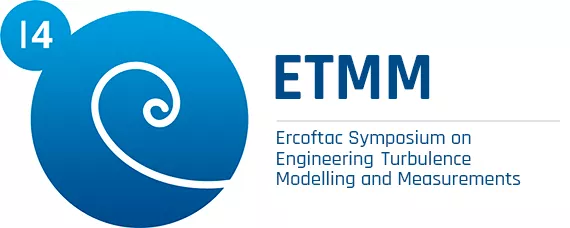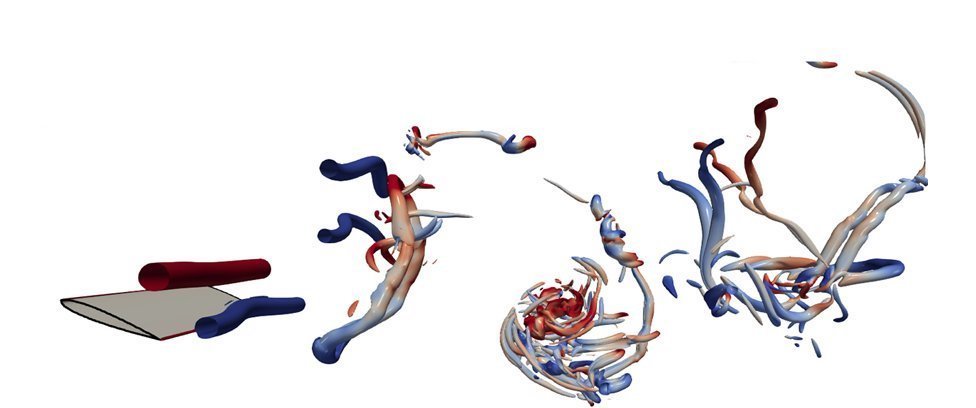Mini Symposia
Advanced Numerical Methods for Scale-Resolving Simulations
Organizers: Francesco Capuano, Gennaro Coppola and Xavier Trias
Over the last decades, Computational Fluid Dynamics (CFD) has become a widespread research and design tool in many fields of enormous societal impact, including biomedicine and renewable energies, among others – either alone, or as part of broader (coupled) multi-physics models. The driving force behind this growth is the continuous progress of high performance computing (HPC) systems, in conjunction with the development of efficient numerical techniques and physics-based turbulence models. Furthermore, the quest for increasingly detailed results in multiple fields, together with the difficulties related to experimental campaigns, are pushing the CFD community towards enabling predictive simulations of complex flows in fast turnaround times. While the transition from traditional RANS-based approaches to eddy-resolving techniques has already started, the completion of this paradigm shift is still somewhat far, and requires a wise combination of numerical robustness, physical fidelity and algorithmic efficiency, a set of conflicting requirements that continues to thrill developers and practitioners alike.
In line with the activities of the newly formed ERCOFTAC Special Interest Group (SIG) 55, this minisymposium aims to bring together researchers and end-users working in the broad area of scale-resolving CFD simulations, with particular emphasis on:
- Development of structure-preserving numerical methods, i.e., discretization schemes with secondary conservation properties (e.g. discrete preservation of kinetic energy, enstrophy, helicity, entropy consistency, …) in complex flows, and physics-inspired implicit/explicit LES models.
- Enhancement of robustness and flexibility of numerical simulations, with focus on the development and testing of efficient algorithms for unstructured grids, conservative immersed-boundary methods, dissipation-free schemes, stable multiphysics coupling, and comparisons with conventional stabilization approaches.
- Improvement of algorithmic efficiency, with critical appraisal of low- vs. high-order numerical schemes, development of efficient and non-dissipative time stepping schemes and cost-effective solution procedures.
Current trends in hybrid RANS/LES modeling for turbulent flow simulations
Organizer: Suad Jakirlic
Computational Fluid Dynamics (CFD) has developed to a key technology which plays an important role in design, development and optimization in engineering practice. Traditionally, the prediction of industrially relevant flow configurations has relied heavily on Reynolds-averaged Navier-Stokes (RANS) turbulence models based on single-point closures and a single characteristic length scale associated with energy-containing large-scale motions. While these models have been widely used, they are inherently limited. In particular, they are unable to capture a significant portion of the turbulence spectrum. As a result, flows dominated by organized, large-scale coherent structures - common in applications such as automotive and aircraft aerodynamics or internal combustion engines - cannot be accurately represented by conventional RANS models. Given these limitations, the scientific and engineering community has recognized that accurate prediction of such complex flow phenomena requires advanced turbulence models capable of reproducing fluctuating flow fields, at least to some degree.
Particularly well suited for handling such flows, even at higher Reynolds numbers, are the hybrid RANS/LES (Large-Eddy Simulation) methods. Their goal is to provide a computational method that can reasonably represent the unsteadiness of the flow by combining the advantages of the RANS and LES approaches. The practice of coupling RANS and LES methods to reduce spatial and temporal resolution has become increasingly popular in the CFD community. The representative length (and time) scales of the residual turbulence entering the relevant equations of motion in the hybrid LES/RANS methodologies are determined by solving the respective equations describing the dynamics of the corresponding turbulence quantities, in contrast to the LES framework, which primarily uses the Smagorinsky type subgrid-scale models (0-equation models), where the grid spacing represents the characteristic size of the largest unresolved scales (subgrid-scales). Accordingly, the basis of any hybrid RANS/LES method is a RANS-based model formulation that describes the unresolved sub-scale portion of the turbulence. The RANS-based sub-scale models of different complexity are appropriately “sensitized” to account for turbulence unsteadiness (fluctuating turbulence). In the last three decades, since the proposal of DES (Detached-Eddy Simulation, Spalart et al., 1997; see also Spalart, 2009; Ann. Rev. Fluid Mech. 41 for further DES related model versions, Delayed DES and Improved DDES), there has been increased activity in the development of hybrid LES/RANS methods for turbulent flow simulations, see e.g. Girimaji (2006, Partially-Averaged Navier Stokes – PANS, J. Appl. Mech. 73), Fröhlich and von Terzi (2008, Prog. Aerosp. Sci. 44), Menter and Egorov (2010; Scale-Adaptive Simulation – SAS, Flow, Turbul., Combust. 85), Deck (2012, Zonal DES – ZDES, Theor. Comput. Fluid Dyn. 26), Chaouat (2017, Partially Integrated Transport Model – PITM, Flow, Turbul., Combust. 99), Jakirlic and Maduta (2015, Sensitized RANS, Int. J. Heat and Fluid Flow 51), Heinz (2020, Prog. Aerosp. Sci. 114), David, Mehta and Manceau (2024, Flow, Turbul., Combust. 114).
The goal of this mini-symposium is to provide an opportunity for participants to present their latest findings and highlight recent advances in the field.
Data-driven Techniques for Prediction and Optimization of Wall-bounded Turbulent Flow Problems
Organizers: Saleh Rezaeiravesh and Philipp Schlatter
This mini-symposium aims to bring together experts from various areas to present and discuss state-of-the-art methods for data-driven prediction and optimisation of wall-bounded turbulent flows. Despite the vast progress in developing machine learning and data science techniques in the recent years, many of such approaches may not be fully appropriate for turbulent flows. Key challenges include the non-linear chaotic turbulence dynamical system, high computational costs demanded by high-fidelity scale-resolving simulations of wall turbulence, and uncertainties/errors in the turbulence data. Therefore, the overarching goal of this mini-symposium is to identify the most promising and effective statistical and data-driven techniques relevant to wall-bounded turbulent flows.
Contributions covering both methodological developments and practical applications are highly encouraged. The topics of interest include, but are not limited to, the following:
- Optimisation and flow control: Methods relying on adjoint sensitivity information, gradient-free approaches such as surrogate-based and Bayesian optimisations, and reinforcement learning techniques particularly for flow control applications.
- Reduced-order models: Methods for decomposing spatiotemporal turbulence fields to identify flow features and structures. These include linear models such as proper orthogonal decomposition and dynamic mode decomposition, as well as nonlinear models such as sparse identification of non-linear dynamics (SINDy) and various types of artificial neural networks. Furthermore, ROMs can be used as cost-effective alternatives to standard numerical and experimental approaches for predicting flow states and variables. A particular challenge in this regard is the accurate prediction of the temporal evolution of turbulent flows over mid to long horizons.
- Uncertainty quantification (UQ): Approaches for uncertainty propagation, sensitivity analysis, and inverse problems (e.g. model calibration). UQ topics may address both parametric uncertainties (e.g., boundary conditions, closure models, and geometry variations) and intrinsic uncertainties, e.g., due to the numerical techniques, measurements, and finite time-averaging.
- Multifidelity models: Strategies for balancing computational cost and predictive accuracy in data-driven studies that require repeated system evaluations due to varying design or uncertainty parameters. Multifidelity models can be used for data fusion from different sources using regression techniques ranging from simple polynomial-based to Gaussian process regression and artificial neural networks.
- Data assimilation: Aims at combining observational and measured data with numerical simulations to improve the accuracy and reliability of their predictions. The relevant techniques can be combined with various types of data-driven methods such as UQ and flow control.
Fundamental Studies of Turbulence, Transition and Loss Mechanisms in Modern Turbomachinery Passages
Organizers: Koen Hillewaert, Fabrizio Fontaneto and Sergio Lavagnoli
The growing availability of high performance computational resources enables to perform ever more ambitious direct numerical simulations (DNS) of the flow in turbomachinery passages. At the same time, experimental techniques are continuously improving, increasing measurement accuracy, resolution and frequency response.
Both evolutions enable to obtain an unprecedented and complete insight in the flow field, including its dynamics as well as detailed statistics, which enables to verify fundamental assumptions and provide detailed calibration data for methods used in industrial design, including both turbulence and transition CFD models, as well as loss and deviation correlations. Accurate data-rich numerical predictions and experimental investigations are necessary to correctly account for the effects of high blade loadings, late and bypass transition, high inlet turbulence, acoustic effects etc..
This mini-symposium is dedicated to the development of both numerical and experimental techniques for their application to the fundamental understanding of flow features in modern turbomachinery passages/cascades or even on measurement devices, with a particular focus on concerted numerical and experimental campaigns on flow analysis or on efforts to reduce the gap between both domains of study.
High-fidelity Simulations of Industrial Flows
Organizers: Stefan Hickel, Ivette Rodriguez and Maria Vittoria Salvetti
Turbulence-resolving numerical simulations, like large-eddy simulations (LES) and direct numerical simulations (DNS), can provide a reliable and detailed description of turbulent flows by eliminating or reducing turbulence modeling errors. On the other hand, these simulations require extensive computational resources, and, consequently, they were typically limited to simple academic flows until recently. Fortunately, the continued growth in computer power and facilities makes possible nowadays to perform high-fidelity LES and DNS simulations for industrial relevant flow configurations. This opens exciting new avenues towards predicting, understanding, and modeling complex turbulent flows.
The goal of the mini-symposium is to establish the state-of-the-art on the generation of high-fidelity data for complex flows of industrial interest by means of turbulence resolving numerical simulations. The topics featured by the mini-symposium are:
- Assessment and analysis of the results of high-fidelity simulations of complex turbulent flows.
- Use of high-fidelity data for the assessment and improvement of low-fidelity approaches.
- Near-wall and closure modeling in large-eddy simulations.
- Assessment of numerical methods for high-fidelity simulations of complex flows.
This mini-symposium is in line with the activities of the ERCOFTAC Special Interest Group SIG1 ‘Large Eddy Simulation’, even though its scope is broader.
Machine Learning for Turbulence
Organizers: Paola Cinnella, Gary Coleman and Ricardo Vinuesa
The application of machine-learning (ML) methods to fluid mechanics has experienced an exponential growth over recent years. Despite this, ML applications to fluid dynamics are still in their infancy, and the encouraging results achieved up to now have been generally restricted to academic problems characterized by simple geometries and flow physics. The availability of abundant, complete and accurate data is currently far from satisfactory in view of the deployment of ML methods to realistic flow problems. On the other hand, fine-detail understanding, accurate modeling and reliable prediction of complex flows remain significant challenges for both fundamental and applied fluid dynamics. The development of a new generation of ML-assisted methods and models for the simulation and modeling of different kinds of flows is a key enabler toward improved predictive capabilities, with impact on the design of more efficient and environmentally-friendly fluid-flow systems.
In this mini-symposium we aim to establish an open dialogue on these very important issues, and generate a sense of community among researchers working on data-driven methodologies for fluid mechanics, with emphasis on turbulence modeling. The development of proper benchmarking practices and configurations to define the state of the art in ML methods for fluid mechanics will also be an important aspect of this mini-symposium. Some of the topics included in this mini-symposium are:
- Data-driven/data-augmented models for different physical phenomena in fluid dynamics, e.g., Reynolds-Averaged (RANS) turbulence modeling, subgrid-scale modeling for LES, wall models for RANS and LES, etc.
- ML-assisted reduced-order modeling or surrogate modeling of fluid flows, feature detection, signal processing, etc.
- ML-based flow-control and optimization.
Near Wall Reactive Flows: Experiments, Simulations and Modelling
Organizers: Suad Jakirlic, Bettina Frohnapfel, Christian Hasse and Andreas Dreizler
Organizers: Suad Jakirlic, Bettina Frohnapfel, Christian Hasse and Andreas Dreizler
- reliable modelling approaches for the simulation of multiscale and multiphysics near wall processes in combustion systems,
- appropriate experimental data required for comprehensive model validation, and
- validation/uncertainty quantification issues for LES in the near wall region.
Uncertainty Quantification and Data Assimilation in Fluid Dynamics
Organizers: Marcello Meldi and Lorenzo Tamellini
The objective of this mini-symposium is to create a platform for researchers in the field of UQ and DA to i) present their findings and identify crucial difficulties, ii) promote dialogue between the participating research team and iii) to establish connections for medium- and long-term collaborations, in particular in the framework of emerging ERCOFTAC’s actions. To this purpose, submissions of works to be presented at the mini-symposium will be encouraged to deal with known open issues the community is currently facing, among which one can list the objectives of ERCOFTAC’s SIG45:
- Usage of sparse information for the observed phenomena at play, which may set the stage for small data problems.
- Development and application of multifidelity and multilevel techniques in UQ and DA algorithms.
- Methods for dynamical systems and strongly time-dependent problems (e.g. highly unsteady flows and extreme events).
- Development of digitals twins / online applications.
- Application of UQ and DA techniques to complex flow problems.
Applications are expected to deal with fundamental and applied analysis of non-linear flow phenomena, in particular turbulent flows. Investigations dealing with complex flows (e.g. transport engineering including navale and aerospace applications, urban flows, energy harvesting, atmospheric reentry, turbomachines, bio-fluid dynamics…) are particularly welcome.
What can we learn from direct numerical simulations of multiphase turbulence?
Organizers: Alessio Roccon, Mahdi Saeedipour and Pedro Costa
Turbulent multiphase flows are commonly encountered in a plethora of natural, environmental, and industrial processes like pollution dispersion, disease transmission, combustion, bubble- column reactors, and powerplant safety. In all these problems, the interplay of phenomena that act on a wide range of spatial and temporal scales determines the time evolution of these systems. Obtaining physical insights into multiphase turbulence is often beyond the reach of experimental or analytical methods. In the past years, simulation methods for multiphase turbulence, from particulate flows to drop- and bubble-laden flows, have been greatly improved thanks to advancements in numerical methods, and increase in computational power available that the proliferation of GPU-based systems has further enhanced. Nowadays, we can perform direct numerical simulations (DNS) of turbulent particle-, drop- and bubble-laden flows with different methodologies, each of which targets different systems configurations and dispersed phase characteristic sizes. This enables us to obtain useful insights into the physics of multiphase turbulence. However, the multiscale character of multiphase flow poses some limitations to the accuracy one can achieve and all simulations, to some degree, involve some modeling.
The mini-symposium aims to bring together scholars working in the field to discuss and present the challenges and current limitations in DNS of multiphase turbulence. Specifically, the mini-symposium has three main objectives:
- Provide a round table for extensive discussion and scientific exchange between the active researchers involved in this topic, particularly about challenges and limitations of direct numerical simulations of multiphase turbulence and what we can/cannot learn from these simulations.
- Define possible common benchmarks and experimental data required for the further development and validation of next generation methods for multiphase turbulence.
- Outline the future research perspective in DNS of multiphase flows with respect to the capabilities and limitations of developed codes and various academic benchmarks as well as relevant industrial problems.



